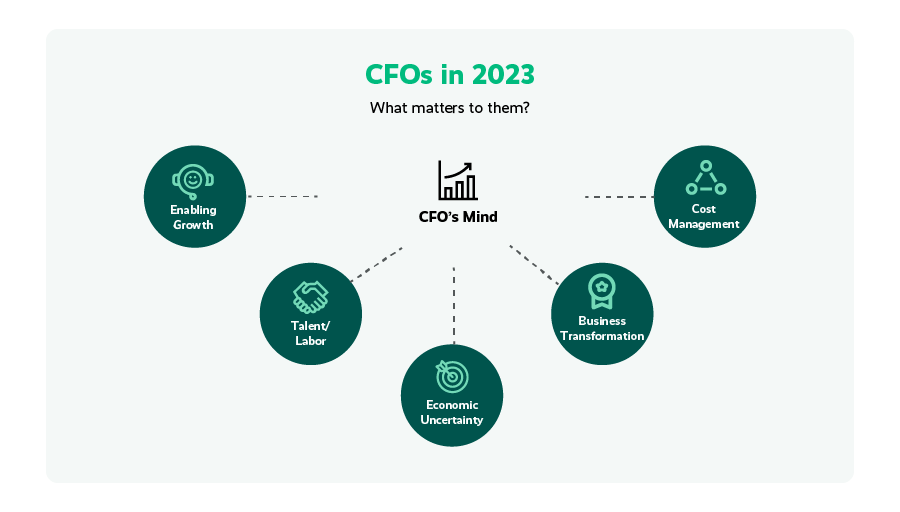How to Sell to a CFO: 7 Proven Tips for Contact Center Leaders
In challenging economic times, organizations need to get creative and pragmatic with cost cutting, expenditures, and revenue generation. As “do more with less” becomes a familiar mantra, contact center leaders are challenged to convince C-suite executives, and especially chief financial officers (CFOs), that not only is it mission critical to deliver outstanding customer experiences (CX), but that it’s also an opportune time to invest in workforce management (WFM) software. Stumped with how to sell to CFOs? Here are seven proven tips.
Understand That CFOs Wear Many Hats
In recent years the role of CFO has evolved. They have overall responsibility for company finance functions and finance teams, forecasting, and accounting, but more frequently are called upon as a key player to help other C-suite executives evaluate the best decisions and buying process for the company’s workforce, sales plans, inventory, supply chains, and the adoption of technology and business automation.
The benefits of implementing contact center software such as Playvox WFM are well established–improved customer experience (CX), increased agent productivity, gained efficiencies, and reduced costs. Since it’s likely your CFO will be involved in the call center business, financial models, and financial decision and approval process for technology investments, it’s critical to translate those benefits into language that “speaks CFO.”

In addition, with today’s economic uncertainty they are keeping a watchful eye on external factors such as interest rates, inflation, and agent employment statistics and trends.
As a call center leader looking to sell an investment in WFM software to your CFO, you need to tie your business case and associated return on investment (ROI) to one or more strategic business priorities. Luckily delivering outstanding customer experiences is likely on top of the list.
Demonstrate Strategic Benefits of Delivering Outstanding CX
On the one hand, approvals for contact center solutions may be under more scrutiny and require a water-tight business case and rapid ROI. However, the silver lining is that there’s never been a better time to convince the C-suite, including CFOs, that delivering outstanding customer experiences is a strategic business objective and competitive advantage.
In a recent Forbes survey, CXOs overwhelmingly believe improving CX is “the number one growth factor.” In addition, they recognize the strong correlation between satisfied employees and satisfied customers—and consider improving both as strategic priorities.
The survey findings list three strategies for improving CX:
- Invest in upskilling employees for the digital world, including contact center agents, to develop and retain talent.
- Invest in technology to bridge the gap between CX and EX (employee experience).
- Focus on process and workflows to affect organizational change and drive operational efficiency
Think Like a CFO
The key success factor for selling anything, including WFM software, to CFOs is to think like a CFO. Simple enough, right? Put yourself in the mindset of a CFO. They want to know:
- Revenue impact
- Cost savings/cost efficiency
- Efficiencies and/or productivity gained
- Return on investment (ROI) and payback period
- Strategic impact on the business
Thankfully agent enablement and contact management solutions, if positioned correctly, can tick all of the above boxes, and a well-researched, well-executed business case can ensure contact center leaders gain CFO and other key stakeholders’ approval.
Do Your Homework
With a better understanding of what matters to CFOs, you should gather information, conduct research, and answer anticipated questions in advance—and quantify them—for a successful outcome and smooth decision-making process. Some considerations for inclusion in your business case:
- Why invest in customer experience and how will the business benefit? How does this fit in with the business strategy?
- How will the investment aid in agent productivity, engagement, and employee retention? The single biggest cost in contact centers or customer success teams is people, so making them more productive saves costs and reduces the need for additional headcount longer term.
- What’s the revenue upside from better customer service delivery?
- What are the cost savings and/or efficiencies gained due to new AI/automation software?
- What changes to support, processes, and workflows are required?
- What are the biggest risks? How will risks be mitigated and potential downsides?
- Are there case studies, industry benchmarks, and other information to help fortify your business case?
Keep It Simple and Straightforward
In your business case or pitch, share only relevant information with the CFO. They care most about the cost/value equation, productivity and efficiencies gained, ROI, and revenue generated (if applicable) for the company. Likewise, in your presentation and supporting material, have your ducks in a row to demonstrate ROI, proformas, cost savings, efficiencies gained, and perhaps most importantly how they tie to strategic business priorities.
There’s a time and a place for fancy, colorful presentations with eye-popping animations–your presentation to the CFO isn’t one of them.
Be Prepared to Answer These Questions
Make it easy for your CFO to say yes by having the answers to these questions:
- Is It budgeted?
- Answer the three whys:
- Why do we need It?
- Why this vendor?
- Why now?
- What is the expected impact on the business?
Educate and Rally Your C-suite Champions
Investing in contact center management software and in contact center agents benefits all areas of the company–sales, marketing, HR, operations, etc. Engage internal champions for help building the business case and selling to the CFO.
Understand each business champion’s goals and objectives and communicate how your investment will benefit their respective areas. Examples include:
- Accurate forecasting will lead to better CSAT because you will be properly staffed across your omnichannel business
- Productivity improvements help reduce labor costs
- Adherence to schedule will drive lower labor costs because you will not be overstaffed
- High Occupancy percentage means a majority of your contact center agents’ time is being spent servicing customers and will also reduce labor costs
- Capacity planning is critical to understanding long-term staffing needs and helps maintain full-time equivalent (FTE) costs
It’s All in the Numbers
Selling contact management software to CFOs doesn’t have to be daunting, even in uncertain economic times. Focus on the strategic business and financial benefits to the company and how it will deliver an impactful ROI. Take the time to create a well-thought-out business case, anticipate questions in advance, and leverage business champions for support.
Need help? Download the Playvox eBook: Succeed In Uncertain Times: Building a Business Case for WFM







